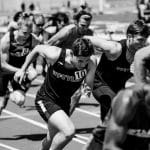If you are a distance runner, you know the feeling. That twinge in your knee that pops up after a long run. Some days it’s a dull throb, other times it’s a sharp and piercing pain. Knee-related injuries are a common plague for distance runners. But what if the solution lies not in the medicine cabinet, but in the way that we run?
In the past few years, a compelling body of scientific research has emerged suggesting that the way our foot strikes the ground as we run, known as our foot strike pattern, may have a significant impact on the forces exerted on our knees and the risk of injury.
Additional reading : What’s the Best Way to Train Agility and Quickness in Badminton Players?
This article will examine the latest research findings on the topic, delving into the debate between forefoot, midfoot and rearfoot striking, and the advantages of running barefoot or shod. With these insights, you may be able to make adjustments to your running form that could help to protect your knees and keep you on track towards your running goals.
Foot Strike Patterns and Their Impact on Running Force and Injury Risk
Understanding your foot strike pattern is crucial for optimizing your running form and reducing the risk of injury. When your foot hits the ground, the impact generates a force that travels up through your foot, ankle, and knee. The way that this force is distributed depends on whether you strike with your forefoot (the ball of the foot), midfoot (the center of the foot), or rearfoot (the heel).
This might interest you : How Can Multidirectional Speed Training Improve Field Hockey Goalkeepers’ Performance?
Several studies have found that rearfoot strikers tend to experience higher impact forces than forefoot or midfoot strikers. One such study, published in the Journal of Sports Sciences, found that rearfoot striking was associated with a higher risk of repetitive stress injuries, including knee injuries.
On the other hand, forefoot and midfoot striking patterns have been associated with lower impact forces and potentially a lower risk of injury. However, some caution that these patterns could increase the risk of other injuries, such as those to the ankle and Achilles tendon.
The Influence of Shoes on Foot Strike Pattern
Running shoes, often referred to as "shod" running in scientific literature, can significantly influence your foot strike pattern. Many modern running shoes have a built-up heel that encourages a rearfoot strike. This, combined with the artificial support and cushioning provided by the shoes, can alter the natural running mechanics and increase the impact force on the knees.
A 2012 study in Medicine and Science in Sports and Exercise found that runners in shoes were more likely to land on their heels, while barefoot runners typically land on their forefoot or midfoot. The researchers concluded that running shoes could contribute to the high incidence of knee injuries among runners.
Barefoot Running and Minimizing Knee Impact
Barefoot running, once the exclusive domain of hardcore running enthusiasts, has gained mainstream recognition due to its potential benefits for reducing impact forces and preventing injuries. When running barefoot, most runners naturally adopt a forefoot or midfoot strike, which can decrease the impact on the knees.
However, barefoot running involves a significant change in running mechanics and requires a careful transition to avoid injury. If you decide to try barefoot running, it’s recommended to start gradually and give your body time to adjust to the new running style.
The Role of Individual Differences in Foot Strike Pattern and Injury Risk
While foot strike pattern is important, it’s only one piece of the puzzle. Individual differences, such as biomechanics, strength, flexibility, and running form, also play a significant role in injury risk.
In a comprehensive review of the scientific literature, researchers from the Journal of Orthopedic & Sports Physical Therapy concluded that no single foot strike pattern is best for all runners. Instead, they suggested that runners should use a foot strike pattern that feels most natural and comfortable for them.
Tailoring Your Running Form to Your Individual Needs
While the scientific evidence provides valuable insights, it’s important to remember that every runner is unique. What works for one person might not work for another.
If you are struggling with knee pain or other injuries, consider working with a physical therapist or running coach who can analyze your running form and suggest individualized modifications. A professional can help you find the optimal foot strike pattern for your body and running style, whether that’s a forefoot, midfoot, or rearfoot strike.
Remember, changing your running form should be done gradually and under the guidance of a professional to prevent new injuries. With time and patience, you can find a running style that feels comfortable, efficient, and sustainable for you.
In summary, while there is no one-size-fits-all solution, understanding your foot strike pattern and how it affects the forces on your knees can be a powerful tool for preventing injuries and enhancing your running performance. Happy running!
Understanding the Biomechanics of Foot Strike Patterns
Grasping the biomechanics of different foot strike patterns is key in improving your running form and mitigating the risk of sustaining injuries. As your foot makes contact with the ground, the generated impact travels upward through your foot, ankle, and knee resulting in what is known as a ground reaction force. The distribution of this force varies depending on your foot strike pattern, be it a forefoot, midfoot or rearfoot strike.
Numerous studies on the topic, available on PubMed Google and Google Scholar, have revealed that rearfoot strikers often encounter higher impact forces than their forefoot or midfoot counterparts. A study featured in the Journal of Sports Sciences demonstrated that runners striking with their heels, or rearfoot, were at an increased risk of repetitive stress injuries, including knee injuries.
Conversely, those employing a forefoot and midfoot strike pattern were found to experience lower impact forces, which could possibly lead to a decreased injury risk. It’s worth noting, however, that these patterns may elevate the risk of developing other types of injuries, specifically those impacting the ankle and Achilles tendon.
The Effect of Running Shoes on Foot Strike Patterns
Your choice of running shoes can have a substantial effect on your foot strike pattern. Modern-day running shoes often feature a built-up heel, encouraging a rearfoot strike. This design, coupled with the artificial support and cushioning running shoes provide, can fundamentally alter your natural running mechanics, resulting in an increased impact force on the knees.
An enlightening study in Medicine and Science in Sports and Exercise (Med Sci Sports Exerc) discovered that shod runners, or those wearing shoes, were more inclined to land on their heels. In contrast, habitually barefoot runners usually land on their forefoot or midfoot. The researchers concluded that running shoes could be a contributing factor to the high frequency of knee injuries among runners.
Conclusion
The relationship between foot strike patterns and knee stress in distance runners is a complex interplay of biomechanics, footwear, and individual factors. Research suggests that forefoot and midfoot striking patterns may reduce knee stress and injury risk, while barefoot running could encourage healthier foot strike patterns.
However, it’s essential to note that there’s no universally optimal foot strike pattern; the best approach varies based on individual biomechanics, strength, flexibility, and running form. If you’re dealing with knee pain or other injuries, it may be beneficial to consult with a physical therapist or a running coach. They can help analyze your running form and propose personalized modifications that can enhance your comfort and performance.
Remember, any alterations to your running form should be implemented gradually and under professional supervision to prevent additional injuries. Knowledge of your foot strike pattern and its effects on knee stress is a valuable tool in injury prevention and performance enhancement. With patience, trial and error, and professional guidance, you can find a running style that suits you best. Let this understanding guide you toward an injury-free, efficient, and enjoyable running journey.











